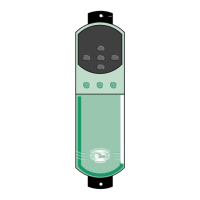Unidrive
LV
model sizes 1 to 3 Installation Guide
Issue code: uliu1
2-10 Installing the Drive
STEP 6 When a braking resistor is to be mounted
outside the enclosure, ensure that it is mounted
in a ventilated metal housing that will perform
the following functions:
• Prevent inadvertent contact with the
resistor
• Allow adequate ventilation for the resistor
When compliance with EMC emission standards
is required, external connection requires the
cable to be armoured or shielded, since it is not
fully contained in a metal enclosure.
Internal connection does not require the cable
to be armoured or shielded.
Minimum resistances and power ratings
Table 2–9 Minimum resistance values and
peak power rating for the
braking resistor at 40°°C (104°°F)
Model Minimum
resistance
Instantaneous
power rating
UNI 1201 ~ UNI 1205 20Ω 15kW
UNI 2201 20Ω 15kW
UNI 2202, UNI 2203 15Ω 20kW
UNI 3201 ~ UNI 3204 5Ω 60kW
The minimum resistance allows the braking resistor
to dissipate up to approximately 300% of the power
rating of the Drive for up to 60 seconds.
For high-inertia loads or under continuous braking,
the continuous power dissipated in the braking
resistor may be as high as the power rating of the
Drive. The total energy dissipated in the braking
resistor is dependent on the amount of energy to be
extracted from the load.
The instantaneous power rating refers to the
short-term maximum power dissipated during the on
intervals of the pulse width modulated braking
control cycle. The braking resistor must be able to
withstand this dissipation for short intervals
(milliseconds). Higher resistance values require
proportionately lower instantaneous power ratings.
In most applications, braking occurs only
occasionally. This allows the continuous power
rating of the braking resistor to be much lower than
the power rating of the Drive. It is essential,
though, that the instantaneous power rating and
energy rating of the braking resistor are sufficient
for the most extreme braking duty that is likely to
be encountered.
Optimization of the braking resistor requires a
careful consideration of the braking duty. This is
described more fully in Optimizing an optional braking
resistor in the Unidrive Advanced User Guide.
S
TEP 7 Select a value of resistance for the braking
resistor that is not less than the specified
minimum resistance. Larger resistance values
may give a cost saving, as well as a safety
benefit in the event of a fault in the braking
system. Braking capability will then be
reduced, which may cause the Drive to trip
during braking. If this occurs, refer to
Deceleration rate in Chapter 2 of the User Guide.
S
TEP 8 Estimate the average power that will be
dissipated in the resistor. A method of
estimating this power is described in Optimizing
an optional braking resistor in the Unidrive
Advanced User Guide. Make a note of this step
number and the average power to be dissipated
in the resistor.
Thermal protection circuit for the
braking resistor
The thermal protection circuit must disconnect the
AC supply from the Drive if the resistor becomes
overloaded. Figure 2–3 shows a typical circuit
arrangement.
Optional
RFI filter
Stop
Start /
Reset
Thermal
protection
device
Braking resistor
Drive
Figure 2–3 Typical protection circuit for a
braking resistor
